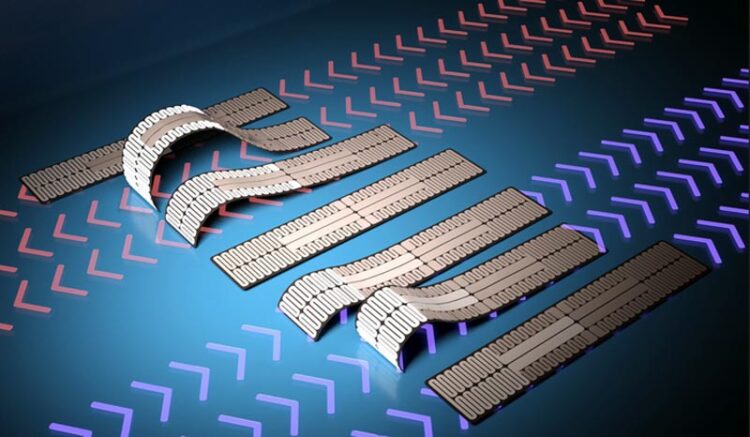Robot caterpillar demonstrates new approach to locomotion for soft robotics

Researchers at North Carolina State University have demonstrated a caterpillar-like soft robot that can move forward, backward and dip under narrow spaces. The caterpillar-bot’s movement is driven by a novel pattern of silver nanowires that use heat to control the way the robot bends, allowing users to steer the robot in either direction.
Credit: Shuang Wu, NC State University
Researchers at North Carolina State University have demonstrated a caterpillar-like soft robot that can move forward, backward and dip under narrow spaces. The caterpillar-bot’s movement is driven by a novel pattern of silver nanowires that use heat to control the way the robot bends, allowing users to steer the robot in either direction.
“A caterpillar’s movement is controlled by local curvature of its body – its body curves differently when it pulls itself forward than it does when it pushes itself backward,” says Yong Zhu, corresponding author of a paper on the work and the Andrew A. Adams Distinguished Professor of Mechanical and Aerospace Engineering at NC State. “We’ve drawn inspiration from the caterpillar’s biomechanics to mimic that local curvature, and use nanowire heaters to control similar curvature and movement in the caterpillar-bot.
“Engineering soft robots that can move in two different directions is a significant challenge in soft robotics,” Zhu says. “The embedded nanowire heaters allow us to control the movement of the robot in two ways. We can control which sections of the robot bend by controlling the pattern of heating in the soft robot. And we can control the extent to which those sections bend by controlling the amount of heat being applied.”
The caterpillar-bot consists of two layers of polymer, which respond differently when exposed to heat. The bottom layer shrinks, or contracts, when exposed to heat. The top layer expands when exposed to heat. A pattern of silver nanowires is embedded in the expanding layer of polymer. The pattern includes multiple lead points where researchers can apply an electric current. The researchers can control which sections of the nanowire pattern heat up by applying an electric current to different lead points, and can control the amount of heat by applying more or less current.
“We demonstrated that the caterpillar-bot is capable of pulling itself forward and pushing itself backward,” says Shuang Wu, first author of the paper and a postdoctoral researcher at NC State. “In general, the more current we applied, the faster it would move in either direction. However, we found that there was an optimal cycle, which gave the polymer time to cool – effectively allowing the ‘muscle’ to relax before contracting again. If we tried to cycle the caterpillar-bot too quickly, the body did not have time to ‘relax’ before contracting again, which impaired its movement.”
The researchers also demonstrated that the caterpillar-bot’s movement could be controlled to the point where users were able steer it under a very low gap – similar to guiding the robot to slip under a door. In essence, the researchers could control both forward and backward motion as well as how high the robot bent upwards at any point in that process.
“This approach to driving motion in a soft robot is highly energy efficient, and we’re interested in exploring ways that we could make this process even more efficient,” Zhu says. “Additional next steps include integrating this approach to soft robot locomotion with sensors or other technologies for use in various applications – such as search-and-rescue devices.”
The paper, “Caterpillar-Inspired Soft Crawling Robot with Distributed Programmable Thermal Actuation,” will be published March 22 in the journal Science Advances. The paper was co-authored by Jie Yin, an associate professor of mechanical and aerospace engineering at NC State; Yaoye Hong, a Ph.D. student at NC State; and by Yao Zhao, a postdoctoral researcher at NC State.
The work was done with support from the National Science Foundation, under grants 2122841, 2005374 and 2126072; and from the National Institutes of Health, under grant number 1R01HD108473.
Journal: Science Advances
DOI: 10.1126/sciadv.adf8014
Method of Research: Experimental study
Subject of Research: Not applicable
Article Title: Caterpillar-Inspired Soft Crawling Robot with Distributed Programmable Thermal Actuation
Article Publication Date: 22-Mar-2023
COI Statement: none
All latest news from the category: Materials Sciences
Materials management deals with the research, development, manufacturing and processing of raw and industrial materials. Key aspects here are biological and medical issues, which play an increasingly important role in this field.
innovations-report offers in-depth articles related to the development and application of materials and the structure and properties of new materials.
Newest articles

Hyperspectral imaging lidar system achieves remote plastic identification
New technology could remotely identify various types of plastics, offering a valuable tool for future monitoring and analysis of oceanic plastic pollution. Researchers have developed a new hyperspectral Raman imaging…

SwRI awarded $26 million to develop NOAA magnetometers
SW-MAG data will help NOAA predict, mitigate the effects of space weather. NASA and the National Oceanic and Atmospheric Administration (NOAA) recently awarded Southwest Research Institute a $26 million contract…

Protein that helps cancer cells dodge CAR T cell therapy
Discovery could lead to new treatments for blood cancer patients currently facing limited options. Scientists at City of Hope®, one of the largest and most advanced cancer research and treatment…



